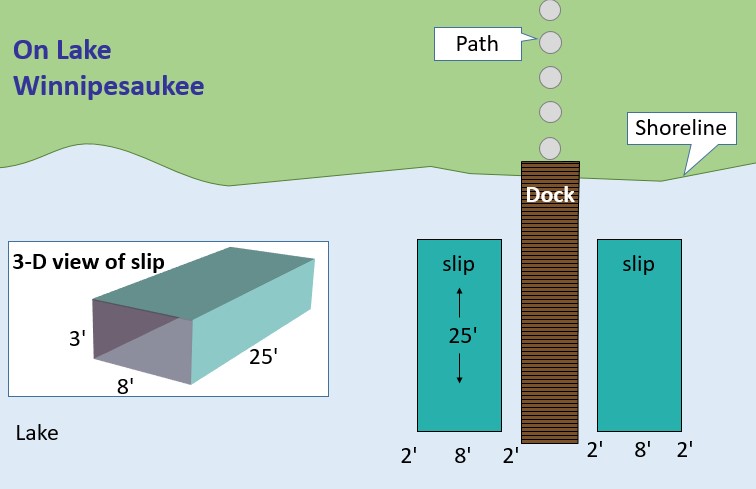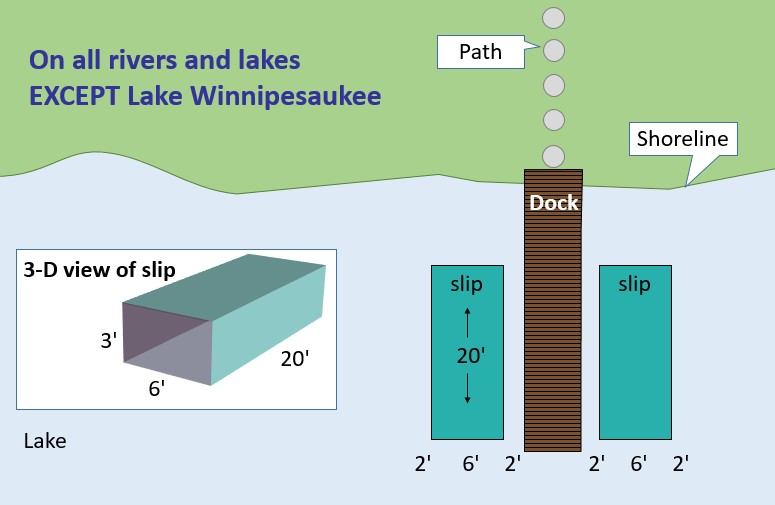Docks in Non-Tidal Areas FAQs
Providing detailed information about wetlands and shoreland regulations.
- Do I need a permit to install or construct a new dock?
- Why do I need a permit to install a dock?
- I have a dock in a non-tidal area. I only want to change it a little. Do I need a permit?
- Is a wetlands permit required to repair a dock in a non-tidal area?
- How big can my seasonal or permanent dock be in a non-tidal area?
- How do I determine the shoreline frontage of my property?
- Can I install a piling or crib dock in a non-tidal area?
- Can I dredge the area around a dock located in a non-tidal area?
- What is a boat slip?
- Do I need a permit for a boat lift or a jet ski lift in a non-tidal area?
- Is a permit required for a canopy over a boat slip in a non-tidal area?
- I have a wetland permit for my dock. Does my permit also transfer ownership of the land under or around my dock?
- How does NHDES determine if a permit can be issued for a dock?
- Can I "grandfather" a dock?
- What if my pre-existing docking structure is associated with filled land in public waters?
- Do I need a permit to install or construct a new dock?
-
Yes. This requirement also includes other docking structures such as boathouses. Within or on the banks of state surface waters, you need a wetlands permit.
Swim rafts and moorings do not require this permit. However, to install them you must still comply with all applicable state laws and rules adopted by the state Department of Safety. For more information, please consult the Department of Safety’s Mooring Program.
- Why do I need a permit to install a dock?
-
The state holds lakes and ponds larger than 10 acres, as well as navigable rivers, "in trust" for general public. To install a dock in public waters means placing it in or on public lands and waters. We are responsible for ensuring that private structures in public water avoid unreasonable adverse impacts on the general public interest. We manage this responsibility in part through applications and permit processes.
- I have a dock in a non-tidal area. I only want to change it a little. Do I need a permit?
-
Before you change the size, location or configuration (footprint) of an existing, legal dock or its structure(s), you need a wetlands permit.
To change only your construction materials, if you comply with all three conditions below, you do not need a wetlands permits:
- You avoid changing the size, location or configuration (footprint) of the dock.
- At the time of repair, you avoid work on any portion of the structure below the water surface.
- You conduct no work in a tidal area.
Common examples of changing construction materials include:
- Replacing wood decking with composite decking.
- Replacing a wooden seasonal dock with an aluminum seasonal dock.
- Is a wetlands permit required to repair a dock in a non-tidal area?
-
Existing, legal docks require a wetlands permit for any repairs that result in any changes to the footprint of the dock. Repairs that do not change the size, location or configuration (footprint) of the dock do not require a wetlands permit, provided these repairs are on portions of a dock that are exposed (in "the dry"), and the lake bed is not disturbed.
- How big can my seasonal or permanent dock be in a non-tidal area?
-
This table shows the maximum standard dimensions for docks. Docks cannot exceed these dimensions.
Maximum Dock Standard Dimensions Freshwater Shoreline Frontage <75Ft. Shoreline Frontage 75+ Ft. Lakes and ponds <1,000 acres 4ft.× 24ft. (seasonal only; permanent structures prohibited) 6ft.× 30ft. (seasonal only; permanent structures prohibited) Lakes and ponds 1,000+ acres 4ft. × 24ft. (permanent or seasonal) 6ft. × 40ft. (seasonal)
6ft. × 30ft. (permanent)Navigable rivers 4ft. × 24ft. (seasonal only; permanent structures prohibited) 6ft. × 30ft. (seasonal only; permanent structures prohibited) - How do I determine the shoreline frontage of my property?
-
“Shoreline frontage” means the average of the length of a straight line drawn between the points where the side property lines intersect the reference line and the length of the natural frontage between the same points.
The shoreline frontage is the average of the black and blue dotted lines, measured between the property lines.
- Can I install a piling or crib dock in a non-tidal area?
-
Permanent docks, such as piling or crib docks, are permitted only on lakes greater than 1,000 acres in size and only in areas where wind or wave conditions prevent the use of a seasonal dock, based on pre-determined criteria. Seasonal docks are less disturbing on lakes as they are removed during the winter months and do not require the use of aerators for protection against ice damage. The use of aerators disrupts normal lakes cycles and creates dangerously thin ice, a hazard to snowmobilers and ice fisherman.
- Can I dredge the area around a dock located in a non-tidal area?
-
Permits may be obtained from NHDES to relocate rocks that are navigational hazards. A rock is considered a navigational hazard to the owner if:
- It is within a boatslip or the approach to a docking structure; and
- It is within 3 feet of the water’s surface.
Dredging of sediments can be permitted only in and around existing, legal fixed structures such as boathouses or breakwaters which cannot be easily modified to attain necessary water depths for docking.
- What is a boat slip?
-
A boat slip is a predetermined, waterbody-dependent, volume of water. For waterbodies 10,000 acres or less, a boat slip is a volume of water 20 feet long, 6 feet wide, and 3 feet deep. For waterbodies greater than 10,000 acres, a boat slip is a volume of water 25 feet long, 8 feet wide and 3 feet deep. Note that only one lake in New Hampshire is greater than 10,000 acres: Lake Winnipesaukee. State rules allow for up to two feet of navigation space around a boat slip. Water depth is measured at the normal high water mark (Figure 2).


- Do I need a permit for a boat lift or a jet ski lift in a non-tidal area?
-
Yes, a wetlands permit is required to install all boat lifts and jet ski lifts, whether seasonal boat or permanent. One boat lift or jet ski lift is equivalent to a single boat slip.
- Is a permit required for a canopy over a boat slip in a non-tidal area?
-
Yes. Only seasonal canopies may be permitted and:
- The canopies must not interfere with boating safety by obstructing lines of sight necessary for navigation.
- All parts of the canopies must be readily removed at the end of the boating season, prior to ice-in.
- And the canopy must not be installed prior to ice-out.
- I have a wetland permit for my dock. Does my permit also transfer ownership of the land under or around my dock?
-
No. For lakes or ponds larger than 10 acres, the state owns the bed of the lake. Your permit allows you to install your dock on or over state land.
For other freshwater lakes, ponds and rivers, the state holds the waters "in trust" for the public. Your permit allows your dock to "interfere" with the public’s right to these waters. Ownership of the bed of these waterbodies depends on several factors. The most important factor is what your deed conveys to the property abutting the waters.
- How does NHDES determine if a permit can be issued for a dock?
-
NHDES uses the criteria set out in the “Fill and Dredge in Wetlands” law (RSA 482-A) and its associated Administrative Rules to balance the rights that an applicant may have to wharf out over a waterbody with the impact of the project on waters, the public, and other interests of the state.
- Can I "grandfather" a dock?
-
In a legal sense, no. However, a docking structure is generally recognized as legally existing if it was in place before the start of any legal requirement to obtain a state permit AND:
- Has been continuously maintained with no change to its location, size and configuration or is a legal replacement structure.
- Has not been abandoned for more than five years.
- Is consistent with the public’s right to reasonable use of public waters, as established in New Hampshire case law.
- Is not built on land created by the unauthorized filling of public waters (i.e., converting public waters to land).
A legal requirement to obtain a state permit started June 22,1967, for docking structures adjacent to tidal waters; July 2,1969, for freshwater permanent docking structures; and September 4,1978, for freshwater seasonal docking structures.
- What if my pre-existing docking structure is associated with filled land in public waters?
-
Structures associated with or that constitute fill in public waters (converting public waters to land) may require a Grant of Right from Governor and Council pursuant to RSA 482-A:17.




